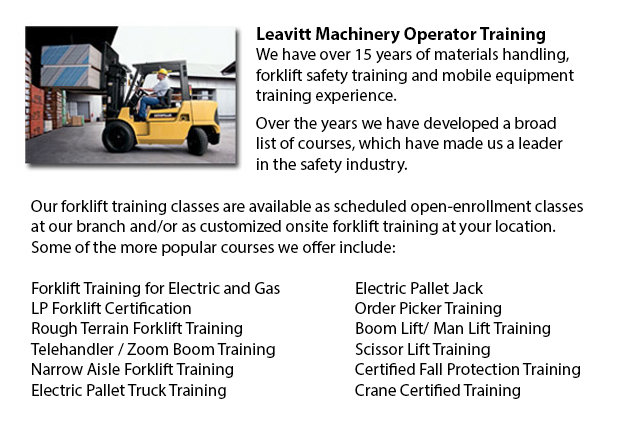
Pallet Stackers Training Alberta - A pallet stacker is a type of pallet jack that is employed to transport, stack and haul palletized commodities that are overly heavy for manual lifting. Its key function is to load and unload pallets on vehicles, and also transferring pallets to and from a variety of places within a storeroom space or warehouse. Most pallet stackers are constructed of heavy duty materials to withstand tremendous weights. Pallet stackers are sometimes referred to as pallet jacks. They may be operated from a seated, upright or walk-behind position. Pallet jacks are divided into manual and powered varieties.
Certain fundamental items comprise the pallet stacker. There are forks which slide underneath a pallet, capable of transporting and raising it to a preferred height. The motor section or casing houses the gas-run, electronic or hydraulic gear that powers the appliance.
Commonly, pallet stackers come in walk-behind designs that are hand-powered. This means that they are moved by pushing and pulling the jack into its desired location, while lifting the heavy pallets will be operated hydraulically making this task much easier. Using a foot pedal or handle raises the stacker’s forks. Squeezing a lever or trigger returns the forks to the ground. These designs of pallet stackers are perfect for lighter loads of up to approximately 1 ton or 907.18 kg.
Most stackers may accommodate the lifting of extreme weights to around 5 tons with either the gas or electric machines. They are physically less demanding to maneuver than the labor-intensive versions thanks to the hydraulic power that hoists and lowers the forks. These models are steered by turning the handle in a particular direction. There is a button on the knob that operates to raise and lower the forks. A throttle found on the stacker’s grips moves the device forward and in reverse. This variety of equipment is regularly referred to as a lift truck and is operated from a sit-down posture.
As the fork width, load limit and lift height fluctuate dramatically between individual designs, choosing the correct pallet jack to fit the activity is critical. Some stacker’s lift height may permit multiple pallets to be stacked, while others might only allow two at a time. Certain designs of these hoists feature an adjustable fork in order to allow the stacker to slide underneath pallets of different sizes and shapes. Various fork models may be quite successful when different types of pallets are being utilized in the same stockroom.
-
JLG Telehandler
JLG Telehandler Training Alberta - Following retirement in the late 1960's, John L. Grove started out on a cross country RV trip. After spending many years establishing his family built crane business with his brother, John had no idea that this trip... More -
Scissor Lifts
Scissor Lift Training Alberta - The scissor lift or table lift, is a mechanical industrial lift that may be adapted to be used in retail, wholesale, manufacturing and production environments. Industrialized scissor lifts have been used mostly within... More -
Pneumatic Forklifts
Pneumatic Forklifts Training Alberta - Pneumatic lift trucks are known as pallet lift trucks or pump trucks and are extensively utilized in warehouses and shipping plants to transfer resources on pallets. Pneumatic jacks consist of a pair of steel bl... More -
Toyota Forklift
Toyota Forklift Training Alberta - Ever since 1992, Toyota Material Handling inc., U.S.A., also known as TMHU, have been the best selling lift truck provider in the United States. This business has been situated out of Irvine, California for well ove... More -
Boom Trucks
Boom Trucks Training Alberta - Boom vehicle are often utilized by phone, cable television and utilities companies as they have extended folded arms which are commonly folded over the roofs of business vehicles. On the end of the extension of extendab... More

Forklift Training Alberta
TOLL FREE: 1-888-254-6157
forkliftcertificationalberta.com/
Email Us
About Us


